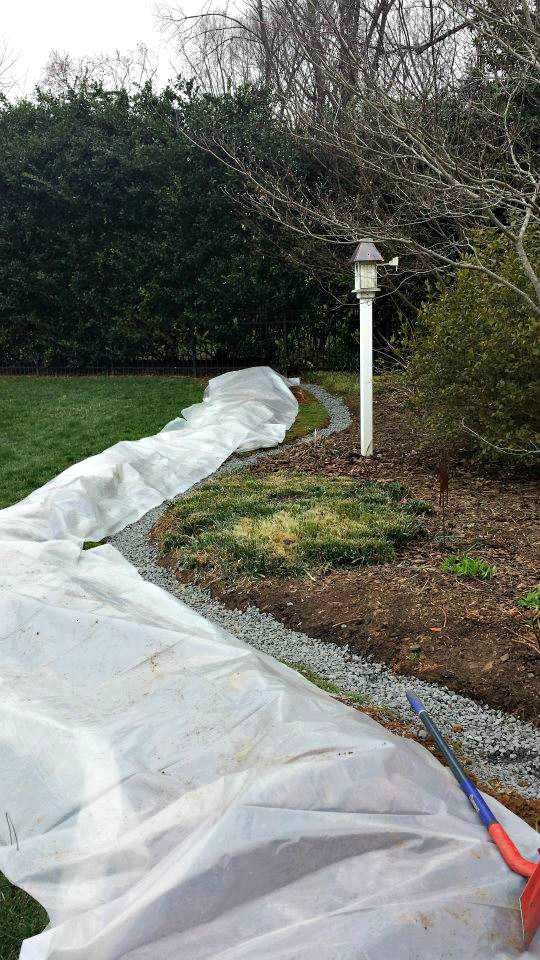The sun is shining, the birds are out, and your drain has seen better days. If you’re looking for smart yard drainage solutions, the good news is: you’ve got plenty of options. Here’s how to reclaim your drain for a more beautiful backyard.

Prevention Pointers
The best way to keep your yard in good shape is by stopping poor drainage in its tracks. Here’s how to set yourself up for success and fewer messes later on.
Clean Downspouts
Otherwise known as a drainpipe, downspouts transfer water from a gutter to the ground. These pipes are effective at doing their job as long as they’re free and clear of debris. A clogged downspout can wreak havoc on your yard and cause water damage, muddy yards, and more.
Keep your downspouts running smoothly by cleaning your gutters regularly and checking the discharge end for potential clogs. Grass and leaves are often the culprits without regular removal. Make sure to check all the downspouts around your home since one gutter may have multiple discharge points.
Survey Your Yard
Keeping a close eye on your yard is the best way to keep potential problems under control. Take a quick walk around your property to check for muddy areas, pools of water, and other drainage issues while paying close attention to areas of previous buildup.
Seasonal changes also impact drainage differently. Remember to clear gutters, especially in autumn after the leaves have fallen, to remove unwanted debris. Check again in early spring to ensure proper drainage for melting snow, ice, and seasonal showers.
Consider a French Drain
French drains, also called pipe and stone drains, can be a beneficial addition to your home. Slotted pipes are buried in a channel filled with stone in order to collect excess water and channel the water away from your home.
Regular Maintenance
One way of getting the best yard in the neighborhood is by staying on top of your regular maintenance. If you’re like many homeowners, you likely have a downspout on your house and a yard drain on your property. Here’s what you need to know to keep your yard drain prepped for proper drainage.
Understanding the Basics
A yard drain or landscape drain is designed to collect water from a downspout into the yard and away from the foundation. Ultimately, this water travels to a nearby street, storm drain, or other drainage point. If you haven’t seen one before, look for a grate in a low area of your yard or pooled water in case of poor drainage.
The drain itself is relatively simple. Think of an underground basin covered by a small metal or plastic grate. The basin is connected to at least one drainpipe and termination point (i.e., a street or storm drain). The pipe itself is usually made of plastic, though individual models vary.
Cleaning Your Drain
As the first order of business, remember to clean your gutters before your drains. Cleaning your drains also starts by checking the grate and clearing off debris. Next, remove your grate and check for debris within the basin itself. The drainpipes should also be cleared of any blockages like garbage or grass clippings using a shop vac. If your drain is connected to multiple pipes, repeat the process as needed.
Next, check for debris, rocks, and other drainage blockages at the termination point of your drainpipe(s). Remove what you can by hand, or use a shop vac for remaining clogs. Check every termination point to clear all drainage exits.
Lastly, use your hose or hoses to flush the drain from the basin. Observe the water flow from the termination point to check whether any remaining debris is being washed out. Once the water runs clear, turn off the hose and replace the grate. Repeat this process as often as needed for optimal drainage and effective yard maintenance.
Divert Runoff
If you’re wondering how to deal with excess runoff, there are a few ways to course correct. Here’s how to put excess water to good use for more effective drainage.
Add Plants
Plants are an excellent way to absorb excess water naturally. Add plants that fit your existing landscaping preferences to blend into your yard while improving your drainage. You might also consider planting a rain garden to make use of excess rainwater from a downspout outlet.
Ditch Turf
Some homeowners prefer turf, though native plants are great at diverting runoff. Unlike turf, plants require water on a regular basis, while native varieties are best suited to the area.
Grow Trees
Most plants are effective at combating water runoff, though trees absorb more water due to their size and reach. If rainfall is heavy in your area, bear in mind that trees slow rainfall and disperse water over a larger area.
Consider Structure
Have you ever thought about the slope of your yard? If you’re experiencing major runoff problems, consider changing the slope of your yard for a more effective drainage solution. Landscapes sometimes change slightly over time, so know that the original slope of your yard may have shifted.
Create Access
Large slabs of concrete or impermeable areas like garages, driveways, and patios effectively block water drainage. Choose more permeable options like brick, flagstone or pavers to allow more water through.
Rethink Runoff
Would you be able to reuse rainwater in your garden or yard? If so, consider getting a cistern for stormwater runoff. You can lower your water bill and solve excess runoff all at once.
Final Thoughts
Preparing your yard for effective drainage mainly involves prevention and maintenance. If you’re still stumped by excess runoff, know there are ways to reuse water to your advantage.
Got other questions about yard drainage solutions? We’d love to help, so be sure to contact us today! Best of luck with your drainage maintenance, and keep us in mind for all your waterproofing needs.
